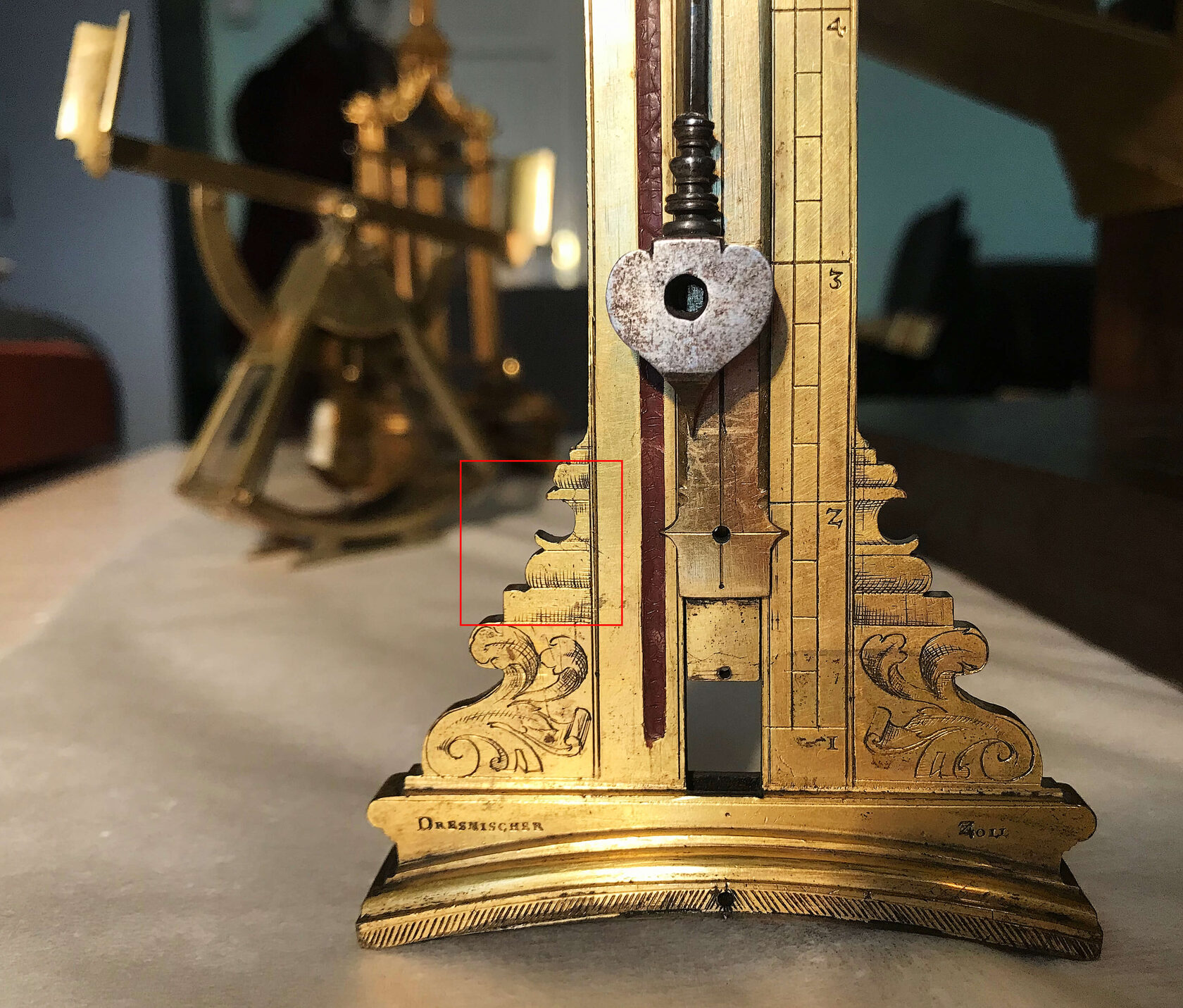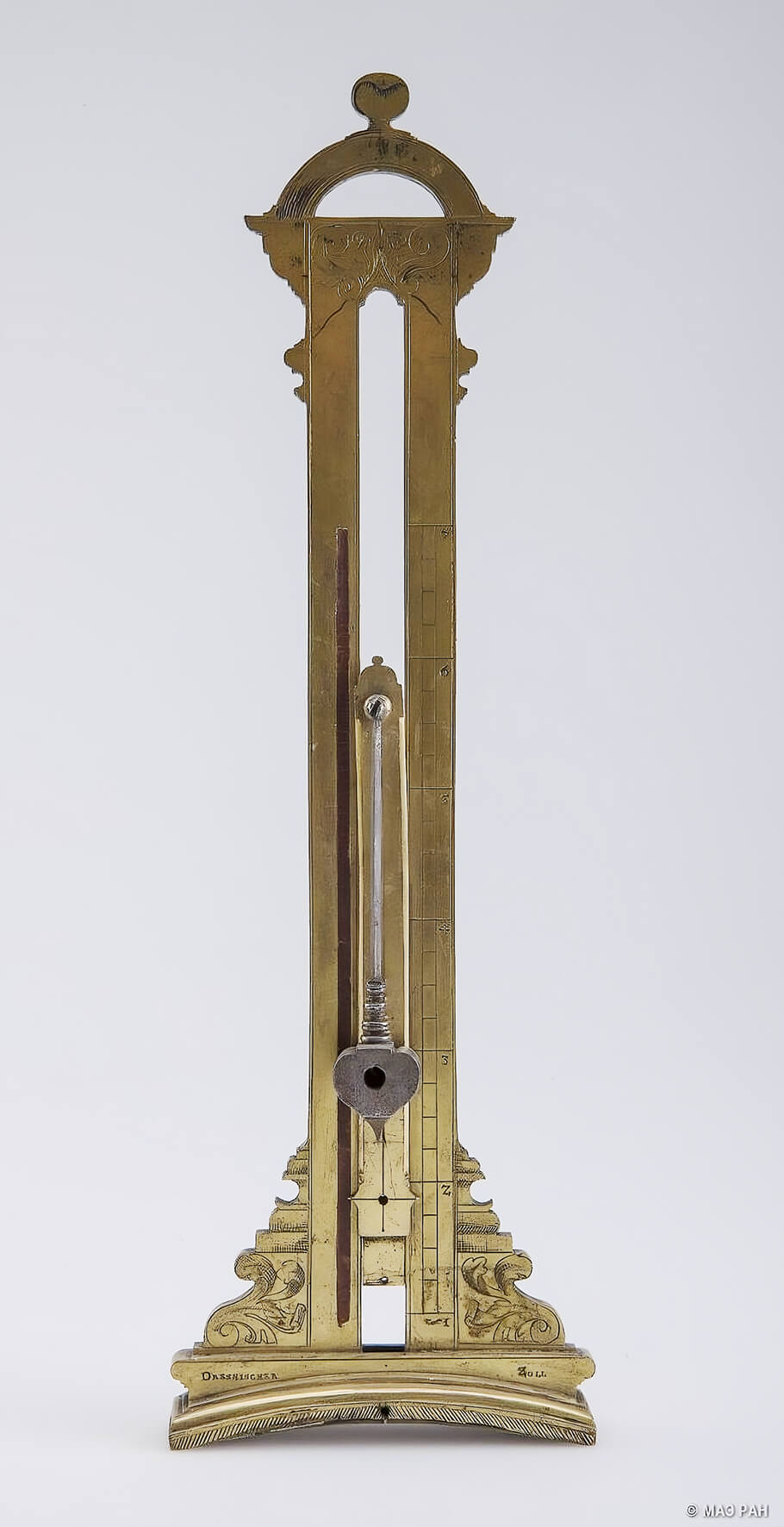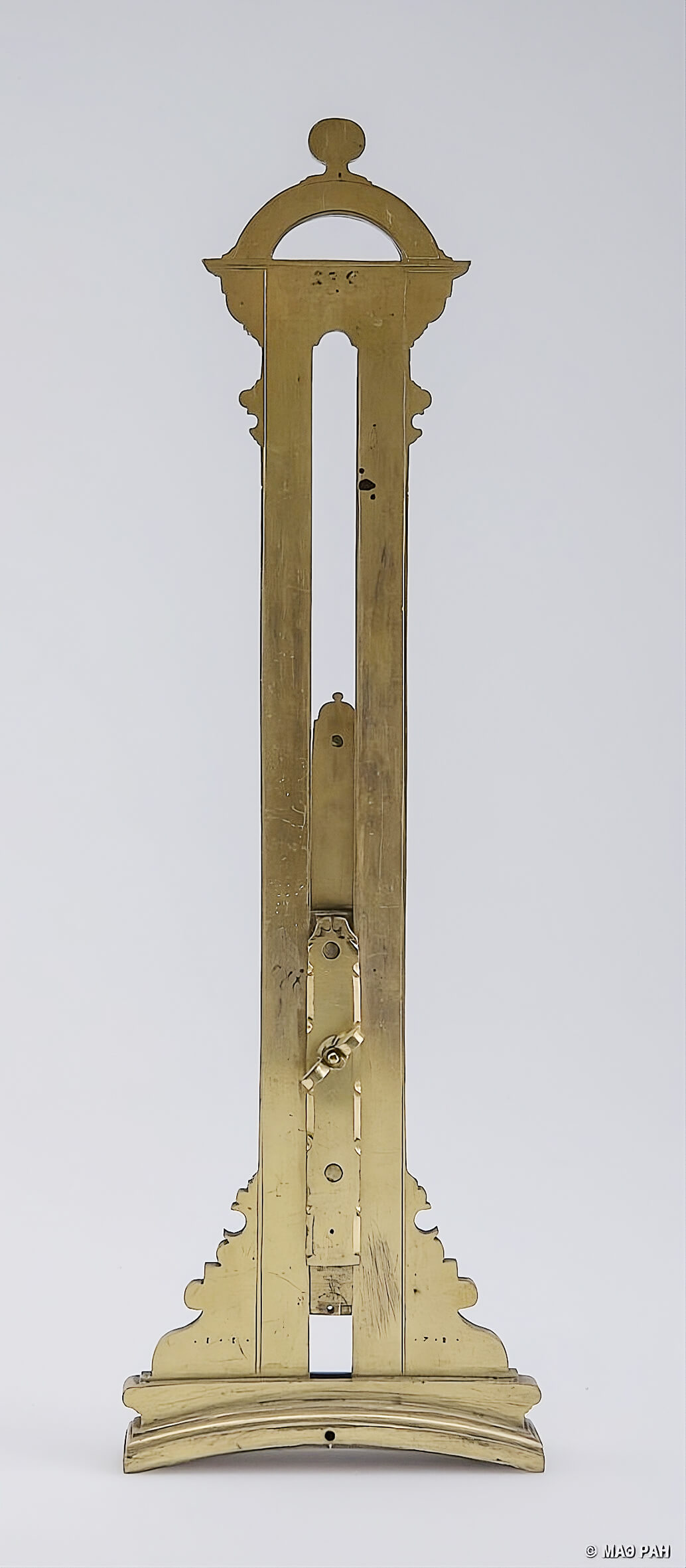The brass sight with level was designed to be mounted on the breech of the cannon.
The primary vertical element, which takes the form of a column with a base and capital on a pedestal, is affixed to an arc-shaped base. The architectural element in question is located above the capitol and comprises a holder in the form of a half-circle with a cut-out segment, topped with a flattened circle finial. The column barrel is equipped with a central slit, within which a slider is located. A sighting hole is present at the base of the slider, while a plumb bob, composed of metal, is located at the apex. The plumb bob is employed for the purpose of horizontal levelling of the artillery piece. This objective is realised through the employment of a heart-shaped weight, which is connected to the slider by means of a screw. The slider is fixed in position by a bar that is secured with a wing nut.
The scale, ranging from 1 to 7, is located on the right side of the front of the vertical bar. The writing of the numeral '2' in the form of the letter 'z' may indicate the German origin of the instrument, as it is known that such writing distinguished the dials of clocks and watches of the same era, made in Germany [1]. An inscription on the base of the instrument reads 'Dresnischer Zoll'. The term 'Dresnischer Zoll' can be translated as 'Dresden inch' [2]. It is evident that the scale is marked in the units of measurement employed in Dresden – the 'Dresden inch' [3] – with a division value of ¼ inch. This finding suggests that the instrument was manufactured in Germany, either in Dresden or for a Saxon customer.
The reverse side of the bar features the date embossed at the bottom: × 1× 5 × 7 × 8 ×
The top of the front of the sight is adorned with an engraved ornament in the form of two mirrored volutes. The column's base is adorned with hatching, creating a volumetric effect. The pedestal is embellished with an engraved ornament in the form of leaves, arranged symmetrically relative to the vertical.
The reverse side of the instrument is devoid of both functional and decorative engraving.
Analogues:
- Unknown maker. Gunner’s sighting device. Europe. 16th century (?). Bronze, metal. Engraved. 13.0 x 6.5 x 1.7 cm. Monuments of the History of Science 14th-19th cc. Fund of the M.V. Lomonosov Museum, MAE RAS (Kunstkamera). MAE NO. 7751-17. ML-2796.
- Unsigned. Trechsler Christoph (style of). Level: Adjustable with Plummet. Germany. Circa 1590. Brass. Gilded. 12.0 x 6.7 x 1.6 cm. Adler Planetarium, Chicago. Object no. M-196. (Cat. no. 6).
- Unknown maker. Gun sight (artillery level). Europe, Germany (?). 1580. Brass, metal. Engraving. 13.0 x 6.7 x 1.7 cm. Monuments of the History of Science XIV-XIX cc. Fund of the M.V. Lomonosov Museum, MAE RAS (Kunstkamera). MAE NO. 7751-15. ML-2779. (Cat. No. 4).
- Unknown maker. Gun attachment. Germany. 1591. Brass, steel. Gilding, engraving, punching. 25.65/39.10 x 7.2 x 3.2 cm. Mathematisch-Physikalischer Salon, Staatlichen Kunstsammlungen Dresden (SKD). Inv. Nr. C V 46. (Cat. No. 7).
[1] Gélis É. L’horlogerie Ancienne : Histoire, Décor et Technique. Paris: Librairie Gründ, 1950. P. 163.
[2] It has been established that the word 'dresnischer' is an obsolete variant of the modern "dresdner", i.e. 'Dresden'. In any case, on the engraved portrait of the Catholic Franz Lauber, who killed the Protestant priest Hermann Joachim Hahn in Dresden on 21 May 1726, there is a signature. The text reads, 'Dresnischer Priester Mörder Frantz Laubler welche den 18 Juli 1726 mit dem Rad von leben zum Tode gebracht worden', that is, 'Dresden priest murderer Franz Laubler, who on 18 July 1726 was executed on a wheel'. The image of the portrait is available in the Deutsche Digitale Bibliothek: Porträt Franz Laubler, Mörder des Predigers Hermann Joachim Hahn // Deutsche Digitale Bibliothek [Electronic resource]. URL. (access date: 24/10/2022).
[3] The process of unification of measurements commenced in France in 1671 and endured for nearly three centuries, ultimately culminating in the adoption of the International System of Units (SI) in 1960. Presently, the SI is utilised by the vast majority of nations worldwide. It is an established fact that until the conclusion of the 17th century, units of measurement were not uniform across different geographical locations, both within and between nations. This diversity in measurement systems persisted even at the urban level, with different cities within a nation exhibiting varied measurement practices. It is noteworthy that the unit was frequently designated with the same nomenclature, yet its numerical values varied. This discrepancy led to the existence of both the Nuremberg foot and the Dresden foot. In Dresden, a foot was defined as approximately 260 millimetres. For a more detailed discussion of this topic, please refer to the work of Krüger J.F. Vollständiges handbuch der münzen, masse und gewicht aller länder der erde. G. Basse, 1830. S. 101 // Google Play Books [Electronic resource]. URL. (access date: 24.10.2022). The inch (Zoll) was equivalent to one-twelfth of a foot. For a comprehensive overview of this subject, consult Cardarelli F. Encyclopaedia of Scientific Units, Weights and Measures : Their SI Equivalences and Origins. London; NY: Springer, 2003. Pp. 3, 378. This information enables the calculation of the 'book' value of the Dresden inch, which is approximately 21.67 mm. It is evident that indirect measurements of the scale divisions of the bar in question yield a value of 22.5 mm. This finding indicates that the bar in question is likely to be the Dresden inch.
Unknown maker. Europe, Germany (?). 1578. Brass, metal. Engraved. 24.0 x 7.5 x 1.7 cm. Monuments of the History of Science 14th-19th cc. Fund of the Museum of M.V. Lomonosov MAE RAS (Kunstkamera). MAE NO. 7751-14. ML-2778.






